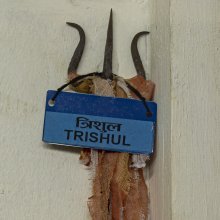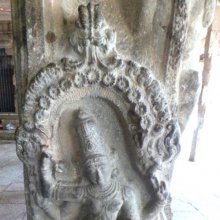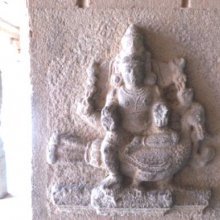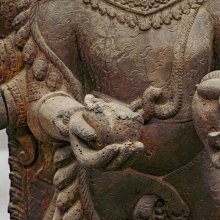Trishula, Triśūla, Tri-shula: 32 definitions
Introduction:
Trishula means something in Buddhism, Pali, Hinduism, Sanskrit, the history of ancient India, Marathi. If you want to know the exact meaning, history, etymology or English translation of this term then check out the descriptions on this page. Add your comment or reference to a book if you want to contribute to this summary article.
The Sanskrit term Triśūla can be transliterated into English as Trisula or Trishula, using the IAST transliteration scheme (?).
Images (photo gallery)
(+47 more images available)
In Hinduism
Natyashastra (theatrics and dramaturgy)
Source: archive.org: The mirror of gesture (abhinaya-darpana)One of the Twenty-eight Single Hands (hasta):—Triśūla (trident): the thumb and little finger are bent. Usage: wood-apple leaf, three together.

Natyashastra (नाट्यशास्त्र, nāṭyaśāstra) refers to both the ancient Indian tradition (shastra) of performing arts, (natya—theatrics, drama, dance, music), as well as the name of a Sanskrit work dealing with these subjects. It also teaches the rules for composing Dramatic plays (nataka), construction and performance of Theater, and Poetic works (kavya).
Shilpashastra (iconography)
Source: Red Zambala: Hindu Icons and Symbols | IntroductionTriśūla (Trident) - Control over action, speech and thought. Also fire — Agni and its 3 forms. The 3 paths to liberation Bhakti – love, Jñāna – wisdom and Karma– skilful action.
Source: Shodhganga: The significance of the mūla-beras (śilpa)Triśūla (त्रिशूल) or Triśūlahasta refers to “triad” and represents one of the twenty-four gestures with a single hand, as defined according to texts dealing with śilpa (arts and crafs), known as śilpaśāstras.—Accordingly, pratimā-lakṣaṇa (body postures of the icons) is comprised of hand gestures (hasta, mudrā or kai-amaiti), stances/poses (āsanas) and inflexions of the body (bhaṅgas). There are thirty-two types of hands [viz., triśūla-hasta] classified into two major groups known as tolirkai (functional and expressive gestures) and elirkai (graceful posture of the hand).

Shilpashastra (शिल्पशास्त्र, śilpaśāstra) represents the ancient Indian science (shastra) of creative arts (shilpa) such as sculpture, iconography and painting. Closely related to Vastushastra (architecture), they often share the same literature.
Purana and Itihasa (epic history)
Source: archive.org: Puranic EncyclopediaTriśūla (त्रिशूल).—A weapon of Śiva with the Vaiṣṇava tejas (brilliance of Viṣṇu) obtained by churning Sūrya. Viśvakarmā made the following: Cakrāyudha (Discus weapon) of Viṣṇu, Triśūla (three-forked spike) of Śiva, Puṣpaka Vimāna (Aerial chariot) of Kubera and the weapon Śakti of Subrahmaṇya. (Chapter 2, Aṃśa 3, Viṣṇu Purāṇa). (See under Viśvakarmā for more details).
Source: archive.org: Shiva Purana - English TranslationTriśūla (त्रिशूल) refers to “tridents”, according to the Śivapurāṇa 2.4.8 (“The battle between the gods and Asuras”).—Accordingly, as Brahmā narrated to Nārada: “[...] Skilled adepts in warfare they hit and smashed one another with tridents (triśūla), double-edged swords, nooses, axes and sharp-edged spikes. Immediately after being hit hard with a trident by Vīrabhadra, Tāraka fell unconscious on the ground. Regaining consciousness quickly Tāraka the excellent Asura got up and forcefully hit Vīrabhadra with his spear. [...]”
Source: Cologne Digital Sanskrit Dictionaries: The Purana IndexTriśūla (त्रिशूल).—The trident of Śiva;1 made from the Vaiṣṇava tejas of the sun filed off by Tvaṣṭa.2
- 1) Brahmāṇḍa-purāṇa III. 32. 14; IV. 19. 6, 85; 20. 81; Vāyu-purāṇa 101. 271.
- 2) Matsya-purāṇa 5. 31; 11. 29; 217. 31 Viṣṇu-purāṇa III. 2. 11.

The Purana (पुराण, purāṇas) refers to Sanskrit literature preserving ancient India’s vast cultural history, including historical legends, religious ceremonies, various arts and sciences. The eighteen mahapuranas total over 400,000 shlokas (metrical couplets) and date to at least several centuries BCE.
Dhanurveda (science of warfare)
Source: Wisdom Library: DhanurvedaTriśūla (त्रिशूल) refers to a weapon (“trident”). It is a Sanskrit word defined in the Dhanurveda-saṃhitā, which contains a list of no less than 117 weapons. The Dhanurveda-saṃhitā is said to have been composed by the sage Vasiṣṭha, who in turn transmitted it trough a tradition of sages, which can eventually be traced to Śiva and Brahmā.
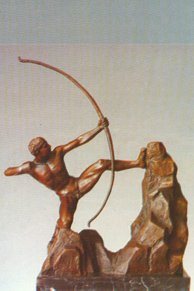
Dhanurveda (धनुर्वेद) refers to the “knowledge of warfare” and, as an upaveda, is associated with the Ṛgveda. It contains instructions on warfare, archery and ancient Indian martial arts, dating back to the 2nd-3rd millennium BCE.
Shaivism (Shaiva philosophy)
Source: Google Books: Manthanabhairavatantram (shaivism)Triśula (त्रिशुल) refers to a “trident” and represents one of the attributes of Svacchanda, according to the Śrīmatottara-tantra, an expansion of the Kubjikāmatatantra: the earliest popular and most authoritative Tantra of the Kubjikā cult. Accordingly, “O goddess, Svacchanda is in the middle, within the abode of the triangle. Very powerful, he has five faces with three times five flaming eyes. [...] O fair lady, my attributes—trident [i.e., triśula], dagger, sword, the king of the snakes, and rosary—adorn the right (arms). O beloved, a skull, double-headed drum, javelin, noose and goad—(these) are my divine, brilliant and very auspicious weapons that (are held) in the left (hands). The king of snakes (hangs) on the shoulder and a garland of skulls hangs (from the neck). There is a necklace of scorpions around the throat and the ears are adorned with snakes. [...]”.
Source: Archaeological Survey of India: Śaiva monuments at Paṭṭadakal (śaivism)Triśūla (त्रिशूल, “trident”).—According to the Vātulaśuddhākhyagama, the significance of the trident is: triguṇaṃ śūlam / (śloka 100b) “the trident is the three qualities”, i.e. it represents the three guṇa, viz. sattva, rajas and tamas. The same Āgama gives the description of Sadāśiva, the deity upon whom the sādhaka or devotee has to meditate. The god should be adorned with various attributes, which are the representations of guṇa, the qualities. This idea becomes very current during later Calukya times. Probably, during the early Calukya period, these ideas must have taken roots. The list starts with the triśūla and the paraśu.
Source: SOAS University of London: Protective Rites in the Netra TantraTriśūla (त्रिशूल) refers to a “trident”, according to the Netratantra of Kṣemarāja: a Śaiva text from the 9th century in which Śiva (Bhairava) teaches Pārvatī topics such as metaphysics, cosmology, and soteriology.—Accordingly, [verse 9.19cd-26, while instructing to visualize Sadāśiva in order to worship the formless Amṛteśa]—“[He] resembles the swelling moon, a heap of mountain snow. Five-faced, large-eyed, ten-armed, [and] three-armed, [he] has a serpent as a sacred thread. He is covered in a garment made of tiger skin. [He] sits in the bound lotus pose atop a white lotus, [holding] a trident (triśūla), blue lotus, arrow, rudrākṣa, [and] a mallet. [...]”.
Source: eScholarship: The descent of scripture: a history of the KamikagamaTriśūla (त्रिशूल) refers to “Śiva’s trident”, according to the Kāmikāgama: an ancient Śaiva Āgama scripture in 12,000 Sanskrit verses dating to at least the 5th century and represented as an encyclopedic account of ritual instructions (kriyāpāda).—In modern print editions, the Kāmika-āgama is structured in two major parts. The Pūrvabhāga consists of 75 chapters (paṭalas) [...] Chapter 66 explains the placement of Śiva’s divine weapons (triśūla-sthāpana). [...] In Chapters 67 to 71, we find accounts of the installation of the throne of knowledge, the installation of Śiva’s ten divine weapons, Śiva’s trident (triśūla-sthāpana), the installation of a “lion’s seat”, and the installation of a chariot for festival processions.

Shaiva (शैव, śaiva) or Shaivism (śaivism) represents a tradition of Hinduism worshiping Shiva as the supreme being. Closely related to Shaktism, Shaiva literature includes a range of scriptures, including Tantras, while the root of this tradition may be traced back to the ancient Vedas.
Shaktism (Shakta philosophy)
Source: Google Books: Manthanabhairavatantram1) Triśūla (त्रिशूल) refers to a “trident”, according to the Manthānabhairavatantra, a vast sprawling work that belongs to a corpus of Tantric texts concerned with the worship of the goddess Kubjikā.—Accordingly, “Candramaṅgalyā (Jñānamaṅgalā) is in the south-west. She sits on an owl. She has one face and three eyes. She has matted hair, which is (adorned with a) Half Moon. She holds a pestle and trident [i.e., triśūla] in her left and right hands, respectively. She wears a garment of human skin and she resounds with the sound of (her) anklets. When the goddess is worshipped in the south-west she consumes inauspicious accidents”.
2) Triśūla (त्रिशूल) refers to the “trident” and as one of the weapons (attributes) of Goddess Kubjikā symbolizes “the attainment of (ultimate) reality”, according to the Manthānabhairavatantra.—Accordingly, “(Now) I will tell (you about) the great weapons of that (goddess) Kubjikā. [...] (One) attains (ultimate) reality by means of the trident [i.e., triśūla] and Māyā is destroyed by means of the wheel. All diseases are destroyed by the thunderbolt while the goad is considered to be (the means to attract and) control. The enemy is destroyed by the arrow. The dagger is the avoidance of obstacles. Wealth is acquired by means of the severed head and the eight yogic powers by the ascetic’s staff”.

Shakta (शाक्त, śākta) or Shaktism (śāktism) represents a tradition of Hinduism where the Goddess (Devi) is revered and worshipped. Shakta literature includes a range of scriptures, including various Agamas and Tantras, although its roots may be traced back to the Vedas.
Kavya (poetry)
Source: Brill: Śaivism and the Tantric Traditions (kavya)Triśūla (त्रिशूल) refers to a “trident”, according to Bāṇa’s Kādambarī (p. 226).—There is a mix of suspicion, fear and reverential awe underlying the image of the forbidding shrine tucked away in the wilds, with its Tāntrika priest who knows not how ‘appropriate’ worship should be conducted, and its blood-spattered, grisly interiors.The very opposite of this ambivalent attitude surfaces in Bāṇa’s unequivocally laudatory poem to Durgā, the Caṇḍīśataka—verse 8 of which is consciously alluded here in “she seemed to be scolding the wild buffalo who had offended by moving the trident-shaft (triśūla-daṇḍa) by scratching his shoulders [on it]”

Kavya (काव्य, kavya) refers to Sanskrit poetry, a popular ancient Indian tradition of literature. There have been many Sanskrit poets over the ages, hailing from ancient India and beyond. This topic includes mahakavya, or ‘epic poetry’ and natya, or ‘dramatic poetry’.
In Buddhism
Tibetan Buddhism (Vajrayana or tantric Buddhism)
Source: Wisdom Library: Tibetan BuddhismTriśūla (त्रिशूल) is the name of a Rākṣasa mentioned as attending the teachings in the 6th century Mañjuśrīmūlakalpa: one of the largest Kriyā Tantras devoted to Mañjuśrī (the Bodhisattva of wisdom) representing an encyclopedia of knowledge primarily concerned with ritualistic elements in Buddhism. The teachings in this text originate from Mañjuśrī and were taught to and by Buddha Śākyamuni in the presence of a large audience (including Triśūla).
Source: academia.edu: The Structure and Meanings of the Heruka MaṇḍalaTriśūla (त्रिशूल) refers to a “trident” and represents one of the items held in the right hand of Heruka: one of the main deities of the Herukamaṇḍala described in the 10th century Ḍākārṇava chapter 15. Heruka is positioned in the Lotus (padma) at the center; He is the origin of all heroes; He has 17 faces (with three eyes on each) and 76 arms [holding, for example, triśūla]; He is half black and half green in color; He is dancing on a flaming sun placed on Bhairava and Kālarātrī.
Source: OSU Press: Cakrasamvara SamadhiTriśūla (त्रिशूल) refers to a “trident” which is used to describe Cakrasaṃvara, according to the Saṃvaramaṇḍala of Abhayākaragupta’s Niṣpannayogāvalī, p. 45 and n. 145; (Cf. Cakrasaṃvaratantra, Gray, David B., 2007).—Accordingly, [while describing the iconography of Cakrasaṃvara]: “In the Saṃvara Maṇḍala atop Mount Sumera within a vajra-canopy there is a variegated lotus, on top of that a palace, in the middle of which is the Blessed Lord, standing in ālīḍhāsana, "archer's pose", [...] possessing a vyāghracarma, "tiger skin" and twelve arms, the foremost arms holding a vajra and ghaṇṭā, embracing Vajravārāhī, the uppermost arms holding a gajacarman, "elephant skin", dripping with blood, the remaining arms holding, starting second from the top, on the right, a ḍamaru, "double-headed drum", paraśu, "axe", kartika, "flaying knife", triśūla, "trident", on the left, a khaṭvāṅga, "staff", kapāla, "skull bowl", pāśa, "noose", and brahmamuṇḍa, "lopped head of Brahma", [...]”.
Note: The triśūla, "trident" symbolizes defeating the tri-viṣa.
Source: MDPI Books: The Ocean of HeroesTriśūla (त्रिशूल) refers to a “trident” (i.e., one of the attributes held in the hands of a deity), according to the 10th-century Ḍākārṇava-tantra: one of the last Tibetan Tantric scriptures belonging to the Buddhist Saṃvara tradition consisting of 51 chapters.—Accordingly, “[...] [He (The Causal Vajra-holder)] stands in the ālīḍha posture with the feet placed on both Hara and Gaurī [He holds] (1) a vajra and (2) a bell, (3)(4) an elephant’s skin, (5) a drum, (6) a knife, (7) an axe, (8) a trident (triśūla), (9) a skull staff, (10) a pot, (11) a noose, and (12) a hairless head in the left and right [hands]. [...]”.

Tibetan Buddhism includes schools such as Nyingma, Kadampa, Kagyu and Gelug. Their primary canon of literature is divided in two broad categories: The Kangyur, which consists of Buddha’s words, and the Tengyur, which includes commentaries from various sources. Esotericism and tantra techniques (vajrayāna) are collected indepently.
Mahayana (major branch of Buddhism)
Source: De Gruyter: A Buddhist Ritual Manual on AgricultureTriśūla (त्रिशूल) refers to a “trident” (suitable for an offering ceremony), according to the Vajratuṇḍasamayakalparāja, an ancient Buddhist ritual manual on agriculture from the 5th-century (or earlier), containing various instructions for the Sangha to provide agriculture-related services to laypeople including rain-making, weather control and crop protection.—Accordingly, [as the Bhagavān teaches the offering manual of the root-heart] “[...] Five arrows and a trident (triśūla) should be driven into the ground. Four arrows should be wound round entirely with five-coloured twine. Four filled jars, four ladles with frankincense and four jars of offering should be placed. One filled with white offerings should be placed in the middle of the maṇḍala. [...]”.

Mahayana (महायान, mahāyāna) is a major branch of Buddhism focusing on the path of a Bodhisattva (spiritual aspirants/ enlightened beings). Extant literature is vast and primarely composed in the Sanskrit language. There are many sūtras of which some of the earliest are the various Prajñāpāramitā sūtras.
India history and geography
Source: Cologne Digital Sanskrit Dictionaries: Indian Epigraphical GlossaryTriśūla.—cf. tiriśūlam (SITI), trident; same as śūla. Note: triśūla is defined in the “Indian epigraphical glossary” as it can be found on ancient inscriptions commonly written in Sanskrit, Prakrit or Dravidian languages.

The history of India traces the identification of countries, villages, towns and other regions of India, as well as mythology, zoology, royal dynasties, rulers, tribes, local festivities and traditions and regional languages. Ancient India enjoyed religious freedom and encourages the path of Dharma, a concept common to Buddhism, Hinduism, and Jainism.
Languages of India and abroad
Marathi-English dictionary
Source: DDSA: The Molesworth Marathi and English Dictionarytriśūla (त्रिशूल).—n m (S) A three-pointed pike or spear; esp. the trident of Shiva.
Source: DDSA: The Aryabhusan school dictionary, Marathi-Englishtriśūla (त्रिशूल).—n m A three-pointed pike or spear; esp. the trident of shiva.
Marathi is an Indo-European language having over 70 million native speakers people in (predominantly) Maharashtra India. Marathi, like many other Indo-Aryan languages, evolved from early forms of Prakrit, which itself is a subset of Sanskrit, one of the most ancient languages of the world.
Sanskrit dictionary
Source: DDSA: The practical Sanskrit-English dictionaryTriśūla (त्रिशूल).—a trident. °अङ्कः, °धारिन् (aṅkaḥ, °dhārin) m. an epithet of Śiva.
Derivable forms: triśūlam (त्रिशूलम्).
Triśūla is a Sanskrit compound consisting of the terms tri and śūla (शूल). See also (synonyms): triśīrṣaka.
Source: Cologne Digital Sanskrit Dictionaries: Edgerton Buddhist Hybrid Sanskrit DictionaryTriśūla (त्रिशूल).—name of a rākṣasa king: (Ārya-)Mañjuśrīmūlakalpa 18.2.
Source: Cologne Digital Sanskrit Dictionaries: Shabda-Sagara Sanskrit-English DictionaryTriśūla (त्रिशूल).—n.
(-laṃ) A trident, a three-pointed pike or spear, especially the weapon of Siva. E. tri three or Tri, and śūla a dar.
Source: Cologne Digital Sanskrit Dictionaries: Benfey Sanskrit-English DictionaryTriśūla (त्रिशूल).—I. n. a trident, [Rāmāyaṇa] 5, 37, 38. Ii. m. Śiva.
Triśūla is a Sanskrit compound consisting of the terms tri and śūla (शूल).
Source: Cologne Digital Sanskrit Dictionaries: Cappeller Sanskrit-English DictionaryTriśūla (त्रिशूल).—[neuter] trident (weapon of Śiva); [adjective] bearing the trident.
Source: Cologne Digital Sanskrit Dictionaries: Monier-Williams Sanskrit-English Dictionary1) Triśūla (त्रिशूल):—[=tri-śūla] [from tri] n. a trident, [Mahābhārata] etc. (Śiva’s weapon, iii, 5009 [Harivaṃśa; Matsya-purāṇa xi, 29])
2) [v.s. ...] m. Name of a mountain
Source: Cologne Digital Sanskrit Dictionaries: Yates Sanskrit-English DictionaryTriśūla (त्रिशूल):—[tri-śūla] (laṃ) 1. n. Idem.
[Sanskrit to German]
Sanskrit, also spelled संस्कृतम् (saṃskṛtam), is an ancient language of India commonly seen as the grandmother of the Indo-European language family (even English!). Closely allied with Prakrit and Pali, Sanskrit is more exhaustive in both grammar and terms and has the most extensive collection of literature in the world, greatly surpassing its sister-languages Greek and Latin.
Kannada-English dictionary
Source: Alar: Kannada-English corpusTriśūla (ತ್ರಿಶೂಲ):—
1) [noun] a three-pronged weapon, with a long staff; a trident.
2) [noun] a god.
3) [noun] a mound of earth, leaves, etc., formed by a colony of ants in digging or constructing their underground nest; an ant-hill.
4) [noun] a cruel man.
Kannada is a Dravidian language (as opposed to the Indo-European language family) mainly spoken in the southwestern region of India.
See also (Relevant definitions)
Starts with (+5): Trishula-kashu, Trishuladanda, Trishuladhara, Trishuladharin, Trishuladharini, Trishulaganga, Trishulahasta, Trishulahata, Trishulaka, Trishulakara, Trishulakhata, Trishulanka, Trishulapani, Trishulapattitadhara, Trishulaprahara, Trishulapuri, Trishulapurimahatmya, Trishulasthapana, Trishulastra, Trishulaubinahullu.
Ends with: Jvalitatrishula, Mahatrishula, Svatrishula.
Full-text (+86): Trishulahasta, Trishulanka, Trishulapattitadhara, Trishulapuri, Trishulaganga, Trishulakhata, Trishulavarapanin, Shula, Shanaishcara, Tiriculam, Pinaka, Trishulaya, Tiri-culamuttirai, Shul, Mahatrishula, Trishulay, Trishulin, Trishula-kashu, Trishul, Sayudha.
Relevant text
Search found 40 books and stories containing Trishula, Tri-shula, Tri-śūla, Tri-sula, Tri-śula, Triśūla, Trisula, Triśula; (plurals include: Trishulas, shulas, śūlas, sulas, śulas, Triśūlas, Trisulas, Triśulas). You can also click to the full overview containing English textual excerpts. Below are direct links for the most relevant articles:
The Religion and Philosophy of Tevaram (Thevaram) (by M. A. Dorai Rangaswamy)
Chapter 4.6 - (f) Symbology of Trisula (the trident) < [Volume 2 - Nampi Arurar and Mythology]
Chapter 3.7 - Andhakasura-murti (conquest of Andhaka Asura) < [Volume 2 - Nampi Arurar and Mythology]
Chapter 4.3 - (b) The seven Tandava Dances of Shiva < [Volume 2 - Nampi Arurar and Mythology]
Amaravati Art in the Context of Andhra Archaeology (by Sreyashi Ray chowdhuri)
Lower Kṛṣṇā Valley (27): Chinna Ganjam < [Chapter 2 - Amarāvatī and other Archaeological Sites of Ancient Andhra Pradesh]
Triratna (triple refuge) < [Chapter 3 - Amarāvatī and the Formative Stage of the Buddhist Art]
Bodhisattva’s Enlightenment < [Chapter 3 - Amarāvatī and the Formative Stage of the Buddhist Art]
The Indian Buddhist Iconography (by Benoytosh Bhattachacharyya)
108 forms of Avalokiteśvara (76): Viṣṇupāṇi Lokeśvara
108 forms of Avalokiteśvara (83): Sarasiri Lokeśvara
Rudra-Shiva concept (Study) (by Maumita Bhattacharjee)
2. Vājasaneyi-saṃhitā (b): Rudra’s weapons < [Chapter 2 - Rudra-Śiva in the Saṃhitā Literature]
2.17. Rudra as Śitikaṇṭha < [Chapter 6a - The Epithets of Rudra-Śiva]
44. Identity between Śiva and Nārāyaṇa < [Chapter 5 - Rudra-Śiva in the Purāṇic Literature]
Sripura (Archaeological Survey) (by Bikash Chandra Pradhan)
Pictographs on the Metal Seals < [Chapter 3 - Sculptural Programme]
Scultures of Sadaksari-Lokesvara < [Chapter 3 - Sculptural Programme]
Copper Plate Inscriptions: Salient Features < [Chapter 4 - The Corpus of Inscriptions]
Related products
